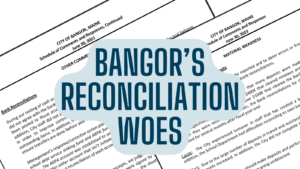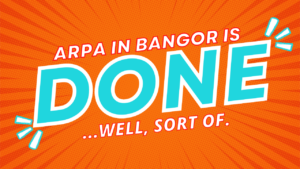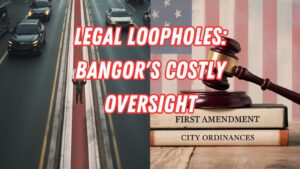
Editor’s Note: This is part of our “Ask AI” series where I ask one of the conversational Artificial Intelligence tools on the Internet about a topic and share the questions and answers with you.
A 2018 marketing campaign by Domino’s Pizza is making the rounds again on social media. The gimmick was pretty good: bad roads are bad for delivering pizza… so they fixed the roads. Domino’s Pizza paid crews to fill in potholes and then paint the Domino’s Pizza logo on the finished work.
If you live or work in Bangor, Maine you know that many of our roads could use some love. Potholes aren’t hard to find and typically they find you first. Residents want to see their roads get fixed and the city of Bangor has released a paving schedule of sorts. It’s an alphabetical listing of streets that potentially might see paving work done this year with no specific time table. It also comes with a disclaimer that the list is subject to change. What purpose does it serve the residents who live on those streets? Gives them a glimmer of hope, I guess.
The Downtown Bangor Partnership has a wonderful all-volunteer “Adopt-a-Garden” program. The Domino’s campaign got me thinking… could Bangor benefit from an “Adopt-a-Pothole” program?
Today we’re asking Gemini AI about that.
Q. Have you heard that Domino’s Pizza is now filing potholes in cities across the United States?
No, Domino’s isn’t directly filling potholes themselves. However, they did run a campaign called “Paving for Pizza” in 2018 where they provided funding to cities to fix potholes. They did this to promote their carryout service and ensure pizzas arrived safely at customers’ homes. The campaign ended in 2018, so it’s unlikely they are still filling potholes today.
Q. What do you think about another company doing a campaign like this today?
A company running a campaign like Domino’s “Paving for Pizza” today could be positive for a few reasons:
- Positive PR: It positions the company as community-minded and willing to address customer concerns (bumpy roads damaging pizzas).
- Brand recognition: The campaign can be eye-catching and generate a lot of media buzz, increasing brand awareness.
- Customer loyalty: Customers might appreciate the company taking action on an issue that impacts them.
However, there are also some things to consider:
- Credibility: The campaign needs to be genuine and not seen as a cheap marketing stunt.
- Measurable results: It would be important to track the campaign’s impact on both road conditions and sales.
- Scalability: Depending on the resources involved, this type of campaign might be difficult to implement nationwide.
Overall, a well-executed campaign like this could be a positive for a company’s image and customer relations.
Q. What if a city, like Bangor, Maine, was to create an “Adopt-a-Pothole” program? What are your thoughts?
An “Adopt-a-Pothole” program in Bangor, Maine could be a beneficial initiative for a few reasons:
Pros:
- Increased community engagement: Residents would have a direct way to improve their roads and take ownership of their neighborhoods.
- Cost-effective solution: By leveraging residents’ willingness to report potholes, the city could potentially save money on pothole detection efforts.
- Prioritization: The program could help the city prioritize pothole repairs based on resident reports, focusing on areas with the most significant problems.
- Improved safety: Faster pothole repairs would lead to smoother roads, reducing the risk of damage to vehicles and accidents.
However, there are also some potential challenges to consider:
- Safety: The city would need to clearly communicate safety guidelines to participants, ensuring they don’t put themselves at risk while reporting potholes.
- Accountability: The city would need a system to track reported potholes and ensure repairs are completed in a timely manner.
- Resident participation: The program’s success would depend on getting enough residents involved in reporting potholes.
Here are some additional thoughts for Bangor to consider:
- Model after existing programs: Bangor could research existing “Adopt-a-Highway” programs in other states to learn from their experiences.
- Technology integration: An online or mobile app could streamline pothole reporting and tracking.
- Incentives: The city could consider offering small incentives, like gift certificates to local businesses, to encourage resident participation.
Overall, an “Adopt-a-Pothole” program has the potential to be a positive addition to Bangor’s infrastructure maintenance efforts. By carefully considering the potential challenges and implementing the program effectively, the city could see improved road conditions and increased community engagement.
Q. Has any location in the United States ever tried an “adopt-a-pothole” program?
There isn’t widespread adoption of “Adopt-a-Pothole” programs in the United States. While the concept has been proposed, there isn’t evidence of a large-scale implementation.
Here’s why you might not find many examples:
- Focus on “Adopt-a-Highway” programs: Many states already have established “Adopt-a-Highway” programs where volunteers remove litter from roadsides. This existing program might fill a similar niche as an “Adopt-a-Pothole” program.
- Liability concerns: Cities might be hesitant due to potential liability issues if a resident gets injured while reporting a pothole.
- Funding and repairs: The core issue of pothole repair lies in funding and resources. An “Adopt-a-Pothole” program wouldn’t necessarily solve the underlying budgetary constraints.
However, there are instances where similar ideas have been explored:
- New Orleans “adopt-a-pothole” (burial plots): This was a satirical proposal, not a real program. The city offered free burial plots in exchange for filling potholes [neutralgroundnews.com].
- Habitat for Humanity’s pothole “adoption”: This was a fundraising campaign where donations were used to repave a parking lot, not a city-wide program [thefmextra.com].
Overall, while there aren’t many examples of true “Adopt-a-Pothole” programs, the concept has the potential to be a creative approach to road maintenance if implemented carefully.
Q. In your opinion is this worth the time and effort of city officials in Bangor, Maine to explore the creation of an “adopt-a-pothole” program?
Whether an “Adopt-a-Pothole” program is worth exploring for Bangor, Maine depends on the city’s specific priorities and resources. Here’s a breakdown to help city officials decide:
Potential benefits:
- Increased community engagement: Residents take ownership of their roads, fostering a sense of community pride.
- Cost-effective solution: Residents help identify potholes, potentially saving the city money on detection.
- Improved prioritization: Repairs focus on the most reported areas, addressing resident concerns.
- Safer roads: Faster pothole repairs lead to smoother roads, reducing vehicle damage and accidents.
Challenges to consider:
- Safety: The city must ensure residents prioritize safety when reporting potholes.
- Accountability: A system is needed to track repairs and ensure they are completed efficiently.
- Resident participation: The program’s success relies on enough volunteers reporting potholes.
Here are some ways Bangor could make it work:
- Learn from existing programs: Research existing “Adopt-a-Highway” programs for best practices.
- Technology: Develop an app for easy pothole reporting and tracking.
- Incentives: Offer small rewards to encourage resident participation.
[Gemini AI’s] overall opinion:
Exploring an “Adopt-a-Pothole” program could be worthwhile for Bangor. It fosters community engagement and potentially improves road conditions. The key is to balance resident safety with efficient pothole repair and address any potential liability concerns. By following existing models and leveraging technology, Bangor could implement a successful program that benefits both the city and its residents.
Ultimately, the decision rests with Bangor’s city officials to weigh the potential benefits and challenges in the context of their unique circumstances.








